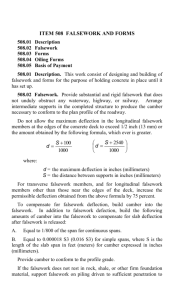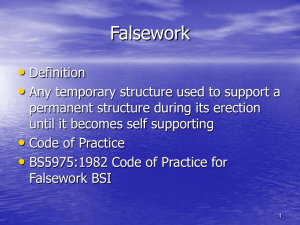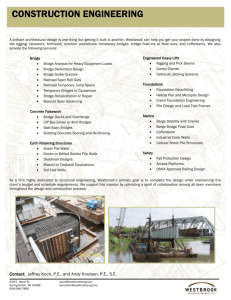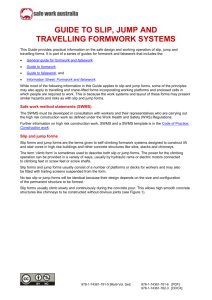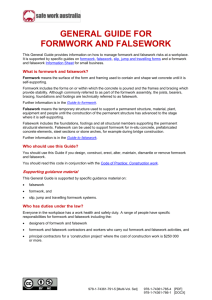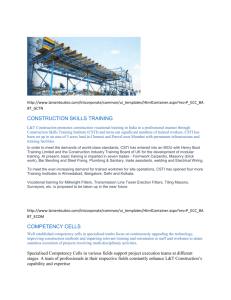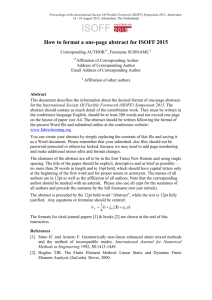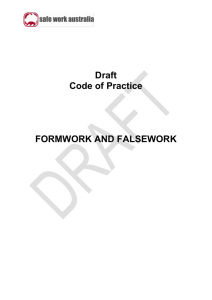3. Guide to falsework
advertisement
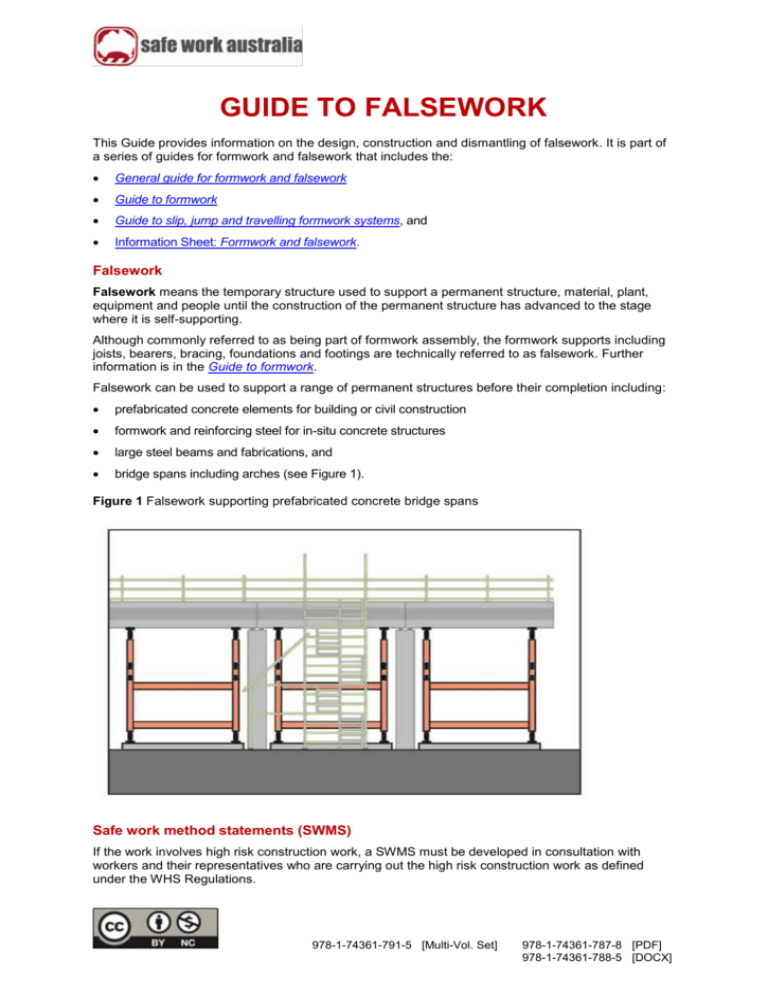
GUIDE TO FALSEWORK This Guide provides information on the design, construction and dismantling of falsework. It is part of a series of guides for formwork and falsework that includes the: General guide for formwork and falsework Guide to formwork Guide to slip, jump and travelling formwork systems, and Information Sheet: Formwork and falsework. Falsework Falsework means the temporary structure used to support a permanent structure, material, plant, equipment and people until the construction of the permanent structure has advanced to the stage where it is self-supporting. Although commonly referred to as being part of formwork assembly, the formwork supports including joists, bearers, bracing, foundations and footings are technically referred to as falsework. Further information is in the Guide to formwork. Falsework can be used to support a range of permanent structures before their completion including: prefabricated concrete elements for building or civil construction formwork and reinforcing steel for in-situ concrete structures large steel beams and fabrications, and bridge spans including arches (see Figure 1). Figure 1 Falsework supporting prefabricated concrete bridge spans Safe work method statements (SWMS) If the work involves high risk construction work, a SWMS must be developed in consultation with workers and their representatives who are carrying out the high risk construction work as defined under the WHS Regulations. 978-1-74361-791-5 [Multi-Vol. Set] 978-1-74361-787-8 [PDF] 978-1-74361-788-5 [DOCX] Further information on high risk construction work, SWMS and a SWMS template is in the Code of Practice: Construction work. Design The falsework designer must be competent in falsework design including documenting temporary work platforms and special equipment needed for safe falsework construction on-site. A designer may use a technical standard or a combination of standards and engineering principles relevant to the design requirements as long as the outcome is a design that meets regulatory requirements. Engineering principles would include mathematical or scientific procedures outlined in an engineering reference manual or standard. Falsework should be designed to carry all loads that may be applied during the various stages of its use including dead, live, environmental and other loads. The design drawings should include design assumptions and a statement of the loads and dimensional changes expected due to loading in all members of the falsework. The drawings should detail member sizes and materials, dimensions, levels, erection procedures and other relevant details including bracing, connections and foundations to ensure erecting, inspecting and using the falsework can be done safely. The design should also include details of methods to provide safe entry to working zones of temporary and permanent structures. Where falsework is required to support a complex structure during construction, for example a stone arch bridge, the structure designer should involve the falsework designer to minimise falsework complexity and health and safety risk during construction and dismantling. Off-the-shelf support systems are generally not suitable for complex falsework unless incorporated into a specifically designed solution as documented by the designer. A site-specific geotechnical investigation should be carried out by a competent person in addition to a geotechnical investigation required for the design of the permanent structure. This will enable the designer to take the existing ground conditions into account for the design and construction of the falsework system. The foundations and footings of the falsework should be designed to prevent excessive settlement and rotation of supports and to maintain overall structural integrity of the falsework and the permanent structure or formwork being constructed. Further information on designing safe formwork and falsework is in the: Code of Practice: Safe design of structures General guide for formwork and falsework, and Guide to formwork. Erection and alteration There are a wide range of applications where falsework may be used to temporarily support a permanent structure (see Figure 2). This often results in one-off designs for the specific work to be undertaken. However, there will generally be common plant and components used to construct falsework structures including prefabricated frames, strongbacks, scaffolding, props and bracing. Falsework should be erected or altered by competent persons in accordance with the designer’s or manufacturer’s instructions and a safe system of work. The risks that need to be controlled in erecting and dismantling falsework are similar to those for formwork including: falls from height falling objects slips and trips, and manual tasks. If work is carried out over vehicle or pedestrian traffic, risk controls can include: Guide to falsework July 2014 Page 2 of 4 establishing exclusion zones temporary closure of roads or railways providing physical barriers like catch platforms, and providing perimeter containment screens to prevent falls and falling objects. Figure 2 Falsework under construction for a road bridge using an elevating work platform with safety harness for safe work at height Foundation material saturated with ground water may result in reduced bearing capacity or lift of the foundation affecting falsework stability. Timber footing pads should not be used if there is a possibility of the pads being under water for even a short period. If timber footings are used, they should be checked for the ability to withstand the applied loads and water impact. A competent person should verify that the timber used is of the type and grade specified in the design. Bracing should be provided longitudinally and transversely to keep the falsework stable during erection and limit significant horizontal movements resulting from the applied loads. Inspection and certification A competent person, for example an engineer with experience in structural design (certifying engineer) should inspect and certify installed falsework meets the design specification and is structurally sound before it is loaded. The certifying engineer should complete and provide a Formwork Structural Certificate to the person with management or control of the falsework, often the principal contractor. An example of a Formwork Structural Certificate is included in the Guide to formwork. Monitoring loading A competent designated observer should continuously monitor the falsework assembly during loading and be provided with an appropriate communication system to alert others in case an emergency arises. Guide to falsework July 2014 Page 3 of 4 No person should be underneath falsework while it is being loaded. Competent persons should be available during loading to carry out any emergency adjustments or repairs. Dismantling falsework Prior to falsework removal, a competent person, for example an engineer with experience in structural design should provide written confirmation the permanent structure is self-supporting and the falsework can be safely removed. Falsework should generally be dismantled in the reverse order of its erection. Back propping arrangements should also be verified before starting removal. For in-situ concrete structures, all or most of the formwork should be removed before the falsework is removed to minimise the risk of formwork falling onto people. Further information Codes of practice, guidance material and other resources are available on the Safe Work Australia website (www.swa.gov.au). Guide to falsework July 2014 Page 4 of 4
